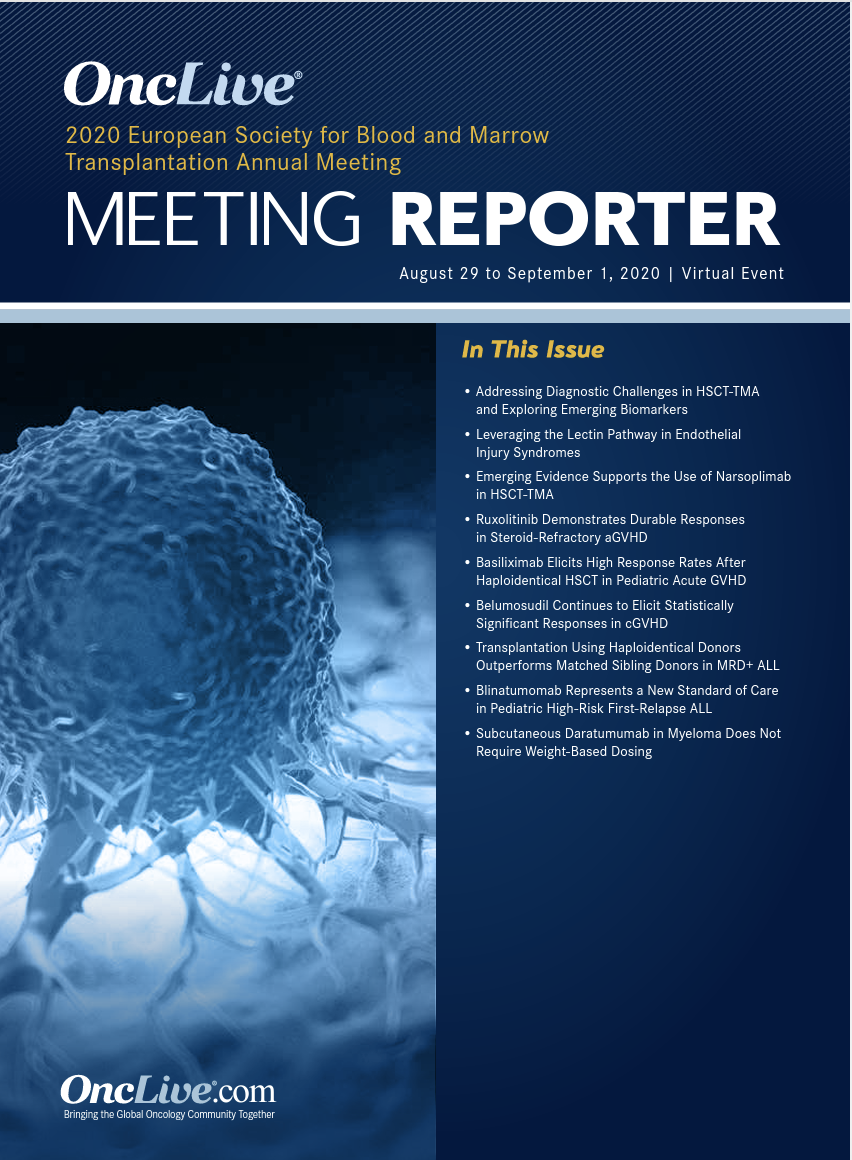Publication
Article
Leveraging the Lectin Pathway in Endothelial Injury Syndromes
Author(s):
Eleni Gavriilaki, MD, PhD, discusses the rationale for the lectin pathway as a therapeutic target in hematopoietic stem cell transplantation–associated thrombotic microangiopathy.
Eleni Gavriilaki, MD, PhD

The rationale for the lectin pathway as a therapeutic target in hematopoietic stem cell transplantation–associated thrombotic microangiopathy (HSCT-TMA) and other endothelial injury syndromes can be easily understood through the involvement of the lectin pathway of complement in endothelial injury, explained Eleni Gavriilaki, MD, PhD, of George Papanicolaou Hospital, in a presentation during the 2020 European Society for Blood and Marrow Transplantation Annual Meeting.
Endothelial damage is fundamental to the pathogenesis of HSCT-TMA and other endothelial injury syndromes. Injury to the endothelial cells can occur chemically, physically, and immunologically, thereby altering the endothelium and resulting in a procoagulant state and complement pathway activation, said Gavriilaki.
Endothelial injury is a precipitating event in the pathogenesis of several severe diseases, including HSCT-related complications. Several factors lead to stem cell transplant–associated endothelial injury, including:
- Chemotherapy/radiation
- Cytokines
- Immunosuppressive therapies
- Bacterial endotoxins
- Engraftment
- Allogeneic reactions
“The stem cell transplant process in general involves many factors that can affect endothelial cells, and endothelial injury is a very common result,” said Gavriilaki.
Endothelial injury can result in organ damage through platelet and leukocyte adhesion, endothelial apoptosis, fibrin-related aggregates, and capillary flow obstruction. Although endothelial injury syndromes present differently according to the organ involved, endothelial injury syndromes contribute to high rates of transplant-related mortality.
Several syndromes can result from transplant-related endothelial injury, including HSCT-TMA, acute graft-versus-host disease (GVHD), and sinusoidal obstruction syndrome/veno-occlusive disease. Despite varying commonality, each syndrome relies on complement activation as a fundamental mechanism of action.
“The syndrome started the most by complement activation is HSCT-TMA,” said Gavriilaki.
The complement system is an important part of the immune system that helps protect individuals against foreign cells and helps remove damaged host cells. The classical, lectin, and alternative pathways each activate the complement system and lead to a terminal pathway.
The lectin pathway is activated when lectins or pattern recognition molecules bind to each other. Lectins recognize damage-associated molecular patterns on the surface of injured endothelial cells. The lectin complexes that contain mannose-binding lectin-associated serine protease-2, bind to damage-associated molecular patterns. Mannose-binding lectin-associated serine protease-2 cleaves C4 and C2, triggering a proteolytic cascade and protein complex formulation. Moreover, mannose-binding lectin-associated serine protease-2 directly cleaves C3 independently of C4 and C2 through the C4 bypass mechanism, similarly activating the downstream complement cascade.
Through this process, C3 and C5a anaphylatoxins trigger monocyte and macrophage activation and stimulate the production of TNF-alpha and interleukin-1 beta, resulting in inflammation, platelet activation, leukocyte recruitment, and endothelial cell activation, explained Gavriilaki.
The lectin pathway cleavage of C3 also generates C3b, which is amplified through the alternative pathway, increasing terminal pathway activity.
The terminal pathway manifests through membrane attack complexes which are formed from C5b-9 protein complexes, leading to further damage to the endothelium and cell lysis.
Notably, mannose-binding lectin-associated serine protease-2 activates the coagulation cascade through cleavage of prothrombin to generate thrombin. Activated thrombin is a key driver of endothelial activation, fibrin deposition, and clot formation, which may contribute to the progression of HSCT-TMA, said Gavriilaki.
Given that the lectin pathway of complement is activated during endothelial injury, inhibiting lectin pathway–mediated complement activity has the potential to reduce thrombosis and hemolysis, and potentially limit damage to affected organs. As such, mannose-binding lectin-associated serine protease-2, the effector enzyme of the lectin pathway, is a potential therapeutic target for HSCT-TMA, concluded Gavriilaki, who added that work is ongoing to bring this research from the bench to the bedside.
Reference
Gavriilaki E. Complement activation in endothelial injury syndromes. Presented at: 2020 European Society for Blood and Marrow Transplantation Annual Meeting; August 30- September 2, 2020; Virtual. Session IS28-2.










